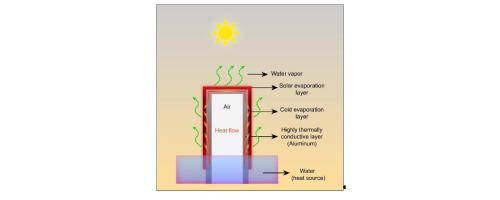Science Bulletin ( IF 18.8 ) Pub Date : 2021-09-23 , DOI: 10.1016/j.scib.2021.09.018 Yida Wang 1 , Xuan Wu 1 , Pan Wu 1 , Jingyuan Zhao 1 , Xiaofei Yang 2 , Gary Owens 1 , Haolan Xu 1

|
Interfacial solar steam generation is an efficient water evaporation technology which has promising applications in desalination, sterilization, water purification and treatment. A common component of evaporator design is a thermal-insulation support placed between the photothermal evaporation surface and bulk water. This configuration, common in 2-dimensional (2D) evaporation systems, minimizes heat loss from evaporation surface to bulk water, thus localizing the heat on the evaporation surface for efficient evaporation. This design is subsequently directly adopted for 3-dimensional (3D) evaporators without any consideration if it is appropriate. However, unlike 2D solar evaporators, the 3D evaporators can also harvest additional energy (other than solar light) from the air and bulk water to enhance evaporation rate. In this scenario, the use of thermal insulator support is not proper since it will hinder energy extraction from water. Here, the traditional 3D evaporator configuration was completely redesigned by using a highly thermally conductive material, instead of a thermal insulator, to connect evaporation surfaces and the bulk water. Much higher evaporation rates were achieved by this strategy, owing to the rapid heat transfer from the bulk water to the evaporation surfaces. Indoor and outdoor tests both confirmed that evaporation performance could be significantly improved by substituting a thermal insulator with thermally conductive support. These findings will redirect the future design of 3D photothermal evaporators.
中文翻译:

使用高导热蒸发器支架增强太阳能蒸汽产生
界面太阳能蒸汽发生是一种高效的水蒸发技术,在海水淡化、杀菌、水净化和处理等方面具有广阔的应用前景。蒸发器设计的一个常见组成部分是放置在光热蒸发表面和大量水之间的隔热支撑件。这种配置在二维 (2D) 蒸发系统中很常见,可最大限度地减少从蒸发表面到大量水的热损失,从而将热量集中在蒸发表面上,实现高效蒸发。这种设计随后被直接用于3维(3D)蒸发器,而不考虑是否合适。然而,与 2D 太阳能蒸发器不同,3D 蒸发器还可以从空气和散装水中收集额外的能量(太阳光除外),以提高蒸发率。在这种情况下,使用绝热体支撑是不合适的,因为它会阻碍从水中提取能量。在这里,传统的 3D 蒸发器配置经过完全重新设计,使用高导热材料而不是隔热体来连接蒸发表面和大量水。由于从大量水到蒸发表面的快速传热,该策略实现了更高的蒸发速率。室内和室外测试均证实,通过用导热支撑替代绝热体可以显着提高蒸发性能。这些发现将重新引导 3D 光热蒸发器的未来设计。











































 京公网安备 11010802027423号
京公网安备 11010802027423号